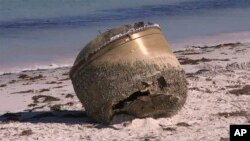ວັດຖຸລຶກລັບອັນນຶ່ງ ທີ່ໄດ້ຖືກຟອງທະເລພັດຂຶ້ນຫາດຊາຍ ຢູ່ຫ່າງໄກ ໃນພາກຕາເວັນຕົກຂອງອອສເຕຣເລຍ ໄດ້ຖືກເຄື່ອນຍ້າຍອອກໄປຂະນະທີ່ທາງການພະຍາຍາມຊອກຫາແຫລ່ງທີ່ມາຂອງມັນ. ໃນເວລານີ້ ບັນດານັກສືບສວນ ເຊື່ອວ່າ ມັນເປັນໄປໄດ້ສູງທີ່ສຸດ ແມ່ນຊາກເສດເຫຼືອຈາກອະວະກາດ. ຟີລ ເມີເຊີ ມີລາຍງານຈາກນະຄອນຊິດນີ ຊຶ່ງໄຊຈະເລີນສຸກ ຈະນຳລາຍລະອຽດ ມາສະເໜີທ່ານ ໃນອັນດັບຕໍ່ໄປ.
ວັດຖຸທີ່ມີຮູບຮ່າງແບບຖັງ ມີຂະໜາດເທົ່າກັບລົດຍົນ ໄດ້ຖືກພົບເຫັນໃນວັນຈັນຜ່ານມານີ້ ຢູ່ທີ່ເຂດ Green Head ຊຶ່ງເປັນເມືອງນ້ອຍແຄມຝັ່ງທະເລ ຕັ້ງຢູ່ກ້ຳເໜືອຂອງເມືອງເພີຕ 250 ກິໂລແມັດ.
ວັດຖຸກະບອກໃຫຍ່ສີທອງແດງໄດ້ຖືກປົກຫຸ້ມໄປທົ່ວດ້ວຍພວກຫອຍທະເລ ເມື່ອມັນຖືກລາກຂຶ້ນມາຈາກນ້ຳໂດຍພວກຄົນໃນທ້ອງຖິ່ນທີ່ໃຊ້ລົດສີ່ລໍ້ຂອງພວກເຂົາ. ວັດຖຸລຶກລັບອັນນີ້ ມີຄວາມກວ້າງປະມານ 2 ແມັດເຄິ່ງ ແລະຄວາມຍາວ 2 ແມັດເຄິ່ງ.
ນັບຕັ້ງແຕ່ນັ້ນມາ ມັນໄດ້ຖືກຍົກຍ້າຍອອກໂດຍທາງການ. ທັງກອງທັບ ແລະອົງການອະວະກາດຂອງອອສເຕຣເລ ແມ່ນກຳລັງເຮັດວຽກຮ່ວມກັບຕຳຫຼວດ ເພື່ອຢາກຮູ້ຈັກວ່າ ມັນແມ່ນຫຍັງ ແລະມັນມາຈາກໃສ.
ບໍ່ຄິດເລີຍວ່າ ມັນຈະເປັນຊິ້ນສ່ວນຂອງເຮືອບິນພານິດ.
ທ່ານແບຣດ ທັກເກີ ເປັນນັກຟີສິກດາລາສາດ ຈາກມະຫາວິທະຍາໄລແຫ່ງຊາດຂອງອອສເຕຣເລຍ.
ທ່ານໄດ້ກ່າວຕໍ່ວີໂອເອໃນວັນພຸດທີ່ຜ່ານມາວ່າ ວັດຖຸລຶກລັບອັນນັ້ນ ອາດເປັນກະບອກຖັງນ້ຳມັນທີ່ຖືກປົດຖິ້ມຈາກຈະຫຼວດຂອງອິນເດຍ.
ທ່ານແບຣດ ອະທິບາຍຕື່ມວ່າ “ຫຼາຍໆຄົນອຽງໄປໃນທາງຂີ້ເຫຍື້ອອະວະກາດ ອາດຈະເປັນຊິ້ນສ່ວນຂອງຈະຫຼວດ. ມັນບໍ່ລະບຸໄດ້ 100 ເປີເຊັນ ແຕ່ກໍມີສິ່ງທີ່ຄ້າຍຄືກັນຫຼາຍຢ່າງໃນການອອກແບບ, ວັດສະດຸຕ່າງໆ ແລະໂຄງສ້າງຂອງຊິ້ນສ່ວນຈະຫຼວດ. ຫຼາຍໆຄົນຄິດວ່າ ເປັນນຶ່ງໃນຈະຫຼວດຂອງອິນເດຍ, ຈາກຍານອະວະກາດ Polar Satellite Launch Vehicle. ແຕ່ມັນຍັງຄ້າຍຄືກັນກັບຊິ້ນສ່ວນອື່ນໆທົ່ວໄປຂອງຈະຫຼວດ. ສະນັ້ນເມື່ອເບິ່ງສະພາບການຂອງມັນແລ້ວ ກໍແມ່ນວ່າ ເປັນຄືກັບທິດສະດີຊັ້ນນຳ ໃນຈຸດນີ້.”
ທ່ານທັກເກີ ກ່າວວ່າ ຮ່ອງຮອຍທີ່ສຳຄັນອັນນຶ່ງໃນກະບອກຖັງນັ້ນ ເປັນໄປໄດ້ສູງ ແມ່ນຈະມີຢູ່ໃນການລະບຸເລກໝາຍ ຫຼືເລກລະຫັດຂອງມັນ.
ທ່ານທັກເກີອະທິບາຍຕື່ມວ່າ “ໂດຍສ່ວນຫຼາຍເປັນຊິ້ນສ່ວນນ້ອຍໆຂອງຂີ້ເຫຍື້ອອະວະກາດ ຫຼືຊິ້ນສ່ວນຂອງຍານອະວະກາດ ກໍມີເລກລະຫັດ ແລະເລກໝາຍຂອງຊິ້ນສ່ວນ. ເມື່ອຊຶ້ນສ່ວນນ້ອຍຂອງຍານອະວະກາດ Space-X ແຕກຫັກອອກແລ້ວຕົກລົງຢູ່ໃນພາກຕາເວັນອອກ ທີ່ລັດນິວເຊົ້າເວລສ໌ ຂອງອອສເຕຣເລຍ ໃນປີກາຍນີ້ ຂ້າພະເຈົ້າ ໄດ້ໄປຫາພວກຊາວກະສິກອນ ແລະພວກເຮົາດຳເນີນງານໃນການລະບຸມັນ ແລະຊິ້ນສ່ວນຂະໜາດໃຫຍ່ ກໍຈະມີເລກໝາຍຢູ່ນຳມັນ. ມັນຈະບໍ່ບອກວ່າ ເຈົ້າກໍຮູ້ ‘ຖ້າຖືກພົບເຫັນ ກະລຸນາສົ່ງຄືນໃຫ້ອິນເດຍ ຫຼື ຈີນ!”
ຕຳຫຼວດໃນພາກຕາເວັນຕົກຂອງອອສເຕຣເລຍ ໄດ້ກ່າວຖະແຫລງເມື່ອວັນອັງຄານຜ່ານມາວ່າ ສິ່ງຕ່າງໆທີ່ບໍ່ສາມາດລະບຸໄດ້ນັ້ນ ໄດ້ຖືກຄື້ນຟອງທະເລພັດຂຶ້ນຝັ່ງທາງພາກເໜືອຂອງເມືອເພີຣຕ໌ນັ້ນ ແມ່ນຊິ້ນສ່ວນຂອງອະວະກາດ “ແລະຈະຖືກກຳກັບຄືຈັ່ງຊັນ ຈົນກວ່າວ່າ ຕົນສາມາດລະບຸໄດ້ວ່າ ເປັນແນວອື່ນ.”
A mystery object that washed up on a remote beach in Western Australia has been removed as authorities try to find out where it came from. For now, investigators believe it is most likely debris from space.
The automobile-sized canister was found Monday at Green Head, a small coastal town, 250 kilometers north of Perth.
The large copper-colored cylinder was covered in barnacles when it was dragged out of the water by locals using their four-wheel drive vehicle. The mystery object is about 2.5 meters across and 2.5 meters long.
It has since been removed by the authorities. The military and the Australian Space Agency are working with the police to find out what it is and where it came from.
It is not thought to have been part of a commercial aircraft.
Brad Tucker is an astrophysicist from the Australian National University.
He told VOA Wednesday that the mystery object might be a discarded fuel cylinder from an Indian rocket.
“A lot of people are leaning towards space junk, probably part of a rocket," he said. "It is not 100% identified but there is a lot of similarities in the design, the materials and the structure to parts of a rocket. A lot of people are thinking one of the Indian rockets, the Polar Satellite Launch Vehicle. But [it] also does resemble generally other parts of rockets. So, given the nature of it that is kind of the leading theory at this point.”
Tucker says that one crucial clue the cylinder is likely to have is an identifying serial or catalogue number.
“With most bits of space junk or parts of spacecraft, there are catalogue and part numbers.," he said. When bits of a Space-X capsule broke apart in eastern Australia, New South Wales, last year, I went down to the farmers, and we worked on identifying it and on the large pieces there are numbers on it. It will not say, you know, ‘if found, please return to India or China!’”
Western Australian police said in a statement Tuesday that the unidentified items that washed up north of Perth are space debris “and will be managed as such until it can be determined otherwise.”





